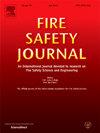Generative artificial intelligence for fire scenario analysis in complex building design layouts
IF 3.3
3区 工程技术
Q2 ENGINEERING, CIVIL
引用次数: 0
Abstract
Performance-based fire safety design requires thoroughly evaluating building fire scenarios to ensure comprehensive fire safety. However, conventional Computational Fluid Dynamics (CFD) fire simulations are computationally intensive and time-consuming, limiting the number of scenarios that can be practically analyzed. This study addresses these challenges by using generative artificial intelligence (AI) to predict fire scenes in realistic multi-room building layouts, characterized by complex shapes and intricate wall partitions. Three generative AI models for image generation are employed for this purpose: GAN-based pix2pix and pix2pixHD, as well as the diffusion model. These models were trained on an extensive dataset of CFD fire simulations to generate near-ceiling smoke movement and temperature distribution outcomes. When tested on new unseen building layouts, these models demonstrated remarkable accuracy and provided near real-time assessments. The diffusion model achieved the highest accuracy (>94 %) while requiring the more computational time. The high performance of these models highlights the potential of using generative AI to enhance fire safety engineering by enabling faster and more comprehensive fire risk assessments.
生成式人工智能在复杂建筑设计布局中的火灾场景分析
基于性能的消防安全设计需要对建筑火灾情景进行全面评估,以确保全面的消防安全。然而,传统的计算流体动力学(CFD)火灾模拟计算量大,耗时长,限制了可以实际分析的场景数量。本研究通过使用生成式人工智能(AI)来预测具有复杂形状和复杂墙壁隔板的逼真多房间建筑布局中的火灾场景,从而解决了这些挑战。为此使用了三种生成式AI图像生成模型:基于gan的pix2pix和pix2pixHD,以及扩散模型。这些模型是在一个广泛的CFD火灾模拟数据集上训练的,以产生接近天花板的烟雾运动和温度分布结果。当对新的未见过的建筑布局进行测试时,这些模型显示出惊人的准确性,并提供了接近实时的评估。扩散模型获得了最高的精度(> 94%),但需要更多的计算时间。这些模型的高性能凸显了使用生成式人工智能通过实现更快、更全面的火灾风险评估来增强消防安全工程的潜力。
本文章由计算机程序翻译,如有差异,请以英文原文为准。
求助全文
约1分钟内获得全文
求助全文
来源期刊

Fire Safety Journal
工程技术-材料科学:综合
CiteScore
5.70
自引率
9.70%
发文量
153
审稿时长
60 days
期刊介绍:
Fire Safety Journal is the leading publication dealing with all aspects of fire safety engineering. Its scope is purposefully wide, as it is deemed important to encourage papers from all sources within this multidisciplinary subject, thus providing a forum for its further development as a distinct engineering discipline. This is an essential step towards gaining a status equal to that enjoyed by the other engineering disciplines.
 求助内容:
求助内容: 应助结果提醒方式:
应助结果提醒方式:


